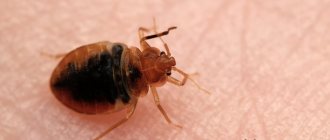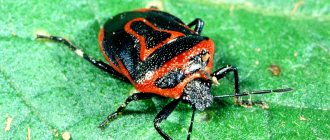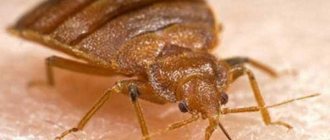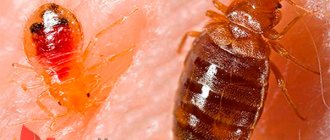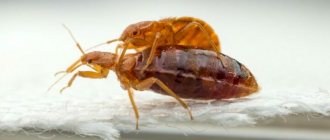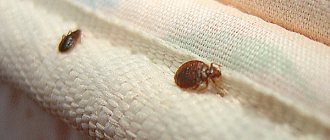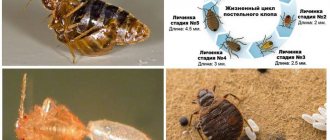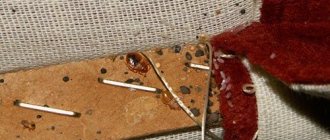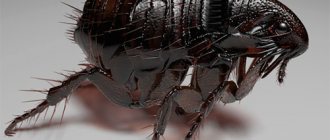The epidemiological significance of bed bugs is still a controversial issue in the medical community. Some are of the opinion that bedbug bites are certainly dangerous to human health and practically equate their danger to tick bites. Others, on the contrary, believe that restless sleep, irritability and a slight allergic reaction are all that bedbugs can bring into your life. We will try to independently understand this problem and determine whether bedbug bites pose a real danger to human health.
What does a bug bite look like?
If there are parasites in the house, bite marks cannot be ignored. Waking up in the morning, you can see red spots and numerous spots on the body, which over time become inflamed and begin to itch very much. Typically marks can be seen on the back, shoulders and neck. After some time, the redness goes away and the itching stops, but there are cases of individual intolerance and allergies.
There are a number of signs by which bedbug bites are identified:
- The consequences of bites are accompanied by a slight swelling with redness of the skin around and a protruding central part.
- If you carefully examine the center of the puncture, you can see a small hole that the bug made with its proboscis.
- Bed bugs rarely bite once. After the attack, a trail remains in the form of tracks at intervals of two to four centimeters. Tracks can start with single points and end with dozens.
- After the bug leaves the bite site, blood continues to seep from under the skin for some time, so small bloody spots remain on the bed linen.
- While sucking blood, the insect injects a specific substance under the human skin, which muffles pain and only after a while the wounds swell and begin to itch.
- Bedbugs come out to hunt only at night; during the daytime they scatter in different corners. Only irresistible hunger can force them to leave the shelter during the day.
- There is a strong burning sensation and a feeling of mild pain at the bite sites. These areas of the body become very itchy and begin to peel off.
The body's reaction depends entirely on the puncture site and the thickness of the skin. The skin on the neck and face is delicate; in these places, bites manifest themselves as more severe redness and swelling and serious pain. An allergic reaction of the body is possible, in which case you need to take an antihistamine.
Differences between bedbug bites and bites of other parasites
Each blood-sucking species has its own specific “style” of bite, traces of which remain on human skin. The methods of sucking blood by bedbugs differ from the bites of other insects.
Mosquitoes
When a person wakes up in the morning and sees inflamed spots on the body, there are assumptions that these are mosquito marks. At first glance, the bite left by a bug resembles a mosquito bite. But subsequently, the number of lesions on the skin, the smooth inflamed path and the bitten places inaccessible to the mosquito, are puzzling, because they were covered with a blanket all night.
The mosquito is not able to get under the blanket and night clothes. In addition, during the cold season there are no mosquitoes.
Fleas
Skin lesions left by fleas can actually be mistaken for a bedbug attack. But there are certain places on the human body that fleas bite most often - armpits, popliteal cavities, waist. These preferences differ from bedbugs. Visually, the mark of a bug bite is difficult to distinguish from a flea bite.
Midges
Midges operate in the summer and bite mainly on the street. The midge attacks open areas of the body, flies into the hair and bites into the scalp. Unlike midges, bedbugs do not bite a person's face. And the moment of a midge bite itself is much more painful, since it does not contain an anesthetic secretion.
Bedbug bites: we analyze in detail all the intricacies of the process
Bed bugs are endowed by nature with a unique element - a piercing-sucking apparatus, which once consisted of two parts of its jaw. Visually, this organ looks like a miniature tube, slightly pointed and quite durable. It easily pierces human skin, but it cannot pierce the skin of a dog. That is why owners of large pets can rest easy, because their four-legged friend will always remain safe.
By the way, it is almost impossible to see the proboscis outside the feeding process. Bedbugs always press it to the lower part of the cephalothorax, which makes it invisible to prying eyes. And some individuals even have a special section that allows them to hide their sharp weapons even more reliably.
Bedbug bites have a characteristic feature that is very recognizable compared to other insects. By carefully puncturing the skin, the parasite skillfully gets to the most important thing - the blood vessel, and the innate ability to sense the pulses of blood in the capillaries helps him in this. In addition, it is almost impossible to feel the moment of puncture: a special anesthetic substance is injected into the resulting wound.
An equally interesting action is the gradual movement of bedbugs over certain areas of the skin. Having received the required dose of blood, they move a few centimeters from the first wound and make the next puncture, thereby forming a certain path of 3-6 bites. During all these manipulations, the adult absorbs about 7 ml. blood, which in general is almost twice its weight.
The situation with bedbug larvae is somewhat different. Firstly, they feed much more often, and not once every 7-10 days, as already fully formed organisms do. Secondly, during their bite, nymphs do not inject an anesthetic substance into the victim’s body, which leads to instant itching even while the insect is feeding.
Can a bug bite only once?
During feeding, the bug bites from one to ten times, but one bite on the entire body is very rare. He walks along a straight line, leaving a characteristic path behind him. The attack sites are located at a short interval from each other.
Bedbug bite marks are usually not limited to one point. Bedbugs like to bite several times, leaving “paths” - several bites nearby.
An adult large insect needs a lot of blood to saturate. During one feeding, he can dig into the body many times.
The nymph larva makes only one bite. She needs a small amount of food and manages to get the required dose after a single dose. Older larvae become saturated after two to three feedings. But only one larva cannot be present in the bed; the parents must also be present somewhere next to it. Therefore, if one dot appears on your body - a bite mark, it is most likely that it was bitten by a mosquito or some other insect, but not a bug.
Who is most often bitten by bedbugs?
When attacking people, bedbugs behave quite selectively. Of two people in bed, sometimes only one can find wounds on the body in the morning.
In such a situation, the question arises, which of the family members do bloodsuckers prefer?
- When given a choice, parasites choose victims with thin skin texture. The smaller the layer of epidermis, the more acutely the taste of blood is felt, and such tissue is easier to bite through.
- Children are the first to be attacked. Adults have much rougher skin. Women are in second place. Men take last place, but the chance of being bitten is not zero.
- Researchers interested in the preferences of bedbugs conducted a study to determine which blood type insects value more. It turned out that there is not much difference for bedbugs, but they prefer the first blood group.
- Bed bugs look for unprotected areas of the skin, because they are not able to attach themselves through clothing, so a victim with a minimum amount of clothing is selected.
We can conclude that for a bloodsucker it does not matter in principle who to bite. Gender and blood type do not affect the choice of victim. For them, only the necessary food and easy ways to obtain it are of paramount importance.
PREVENTION OF BUGS
In some situations, the likelihood that bedbugs will soon appear in the apartment increases. It is in this case that all measures must be taken to prevent this from happening. This should be done immediately if:
- You have recently returned from vacation or a business trip. Even if you happen to live in a high-class hotel, and even more so in someone else’s apartment, be sure to process your belongings. If you did not find the insects themselves on your clothes, this does not mean that they could not lay their larvae there.
- If you decide to move, it is not recommended to immediately transport all your belongings to your new apartment. You should first carry out preventive treatment of the premises against harmful insects.
- If you have had guests in your home for one or more weeks, you need to take preventive measures after they leave.
- Alarm signal: there are bedbugs in your neighbors’ apartment. In this case, carry out the treatment especially carefully, because soon the insects may migrate to you.
How dangerous is a bedbug bite for humans?
Why is a home bedbug bite dangerous for humans? It does not pose a serious threat, but it can cause physical discomfort and cause a person an enormous amount of moral suffering, even leading to a nervous breakdown. Women are very afraid of insects, and the very fact of the presence of some biting bugs in bed can lead to panic and hysteria.
Possible consequences of bites
- For some, small wounds itch slightly, and bedbug bites pass painlessly and unnoticed.
- Susceptible people scratch the damaged areas and lead the wounds to complications and abscesses.
- Of course, there is a small percentage of people who have an allergic reaction and it is quite serious. It can be expressed by a mild form of suffocation or cough. When the allergy is severe, it can end in anaphylactic shock, which is very dangerous.
Danger for pregnant women
Why are bedbug bites dangerous for pregnant women? Changes in hormonal levels and increased stress on a woman’s body provoke nervous breakdowns from the knowledge that there are insects in her bed. Increased sensitivity leads to lack of sleep, fatigue, and weakness.
The danger of a bite is the occurrence of allergies and anemia. Thinning and analgesic fluids affect the development of the fetus through the blood. A pregnant woman may develop:
- allergy;
- anemia;
- secondary infection;
- breakdown.
When there are a large number of harmful insects, their bites affect the normal course of pregnancy. If suspicious pimples and redness appear on the body, you should immediately contact a dermatologist and gynecologist.
Scratch bites are wounds open to bacteria and germs. For a pregnant woman, even a cold creates problems. Many medications have a negative effect on the fetus. Treatment of a disease resulting from secondary infection threatens to inhibit the development of the child and the inheritance of the mother's disease in a chronic form.
Bedbug bites in children
Bedbug bites in children do not look too serious: slight redness and blisters dissolve quite quickly, the main thing is not to let the skin be scratched to avoid infection. The itching goes away and the child does not feel any serious discomfort. If the baby’s body is too susceptible, complications arise in the form of:
- lymph nodes become inflamed;
- an allergic reaction flares up;
- temperature rises;
- headache appears;
- digestion is upset;
- Infection of damaged skin occurs.
These symptoms appear quite rarely. The main discomfort is psychological. Bite-bitten children do not have the opportunity to sleep soundly and normally; this makes them capricious and nervous, which affects the morale of not only the children, but also the parents.
How to treat bedbug bites?
Most often, the marks go away on their own and do not require treatment, but if the itching is unbearable, you can use the following remedies:
- Toilet or tar soap is brought to a foamy state, lubricated inflamed areas and wait for drying. When the inflamed areas stop itching, wash it off.
- Baby cream is rubbed into popped blisters and reduces the desire to scratch the damaged parts of the skin.
- Essential oils and Golden Star balm are great for relieving itching.
There are times when it is necessary to treat abscessing wounds. The problem arises from the fact that many scratching the affected areas cause infection. Mild inflammation can be treated at home. When abscesses are alarming, it is better to consult a specialist.
How long does it take for bedbug bites to go away?
After what period of time the damaged areas of the body calm down depends on the body’s susceptibility.
- In most cases, bites go away within a few hours.
- If the body's immunity is weakened, the damage disappears within 24 hours.
- In rare cases, the resulting allergic reaction can delay wound healing and reduce itching for up to a week.
Why do bed bug bites itch?
Itchy red blisters are caused by a bedbug bite, which during the process uses a special proboscis, divided into two tubules. One releases an anesthetic, the second punctures the tissue and sucks out blood. The human immune system fights the damage, causing the skin to become inflamed and itchy.
Sometimes there may be an allergy to bedbug bites, namely to the anesthetic that he injects under the skin.
HOW TO PREVENT BUGS IN YOUR HOUSE
Finding bedbugs can be quite difficult, so you need to carefully monitor all the changes that occur in your apartment and, preferably, prevent these insects from appearing at all. There are some principles that will help protect your home from bedbugs.
- Since bedbugs can crawl from neighboring apartments even through holes in sockets, it is recommended to replace ordinary sockets with new ones with a closing cover for the plugs.
- Wallpaper joints are hiding places for bedbugs. It is necessary to carefully check them, glue them, and, if such an opportunity exists, then replace the outdated wallpaper with new ones.
- All possible defects should be eliminated: cracks, crevices, uneven joints.
- It is necessary to regularly carry out preventive measures: treat the room with a special product, for example, RAPTOR Destruction of bedbugs. However, bedding cannot be treated with such an aerosol; it is better to have it dry cleaned.
- If you suspect the presence of bedbugs, then in winter you can leave your clothes and bedding in the cold for several hours.
How to protect yourself from bedbug bites?
If it is not possible to quickly get rid of blood-sucking parasites and begin removing them, you can protect yourself from attacks at night. Some tips for repelling:
- Blood suckers cannot tolerate substances containing alcohol additives. By anointing yourself with cologne, lotion or perfume, a person has a chance to get a good night's sleep.
- Essential oils are great for these purposes.
- Exposed areas of the body can be lubricated with fish oil.
- A homemade decoction of edible cloves with cologne will perfectly repel bedbugs, protecting the skin from damage.
Entrust the destruction of bed cops to professionals and you will forget about the problem once and for all!
Flat, wingless insects with the scientific name Cimex lectularius, which are called bedbugs, have happily coexisted with humans for centuries, feeding on their blood. In the middle of the last century, the organochlorine compound DDT began to be used en masse to combat agricultural and household pests, not knowing about the hidden dangers of this pesticide. At first, DDT reliably destroyed insects, as a result of which the problem of bedbugs seemed to be eliminated and forgotten for decades. That is why the modern generation is little familiar with them, and today they learn information about how bedbugs bite humans from photos and articles on the Internet.
How bedbugs bite - facts from biology
The mouthparts of bed bugs are adapted for piercing skin and sucking blood. It consists of thin needle-shaped stylets that are inserted into the skin and then pulled out when the insect has had its fill. After removing the stilettos, blood sometimes leaks out at the site of the bite, causing brown spots to remain on the bed.
When do bedbugs start biting?
Bed bugs begin to feed on blood from the moment they emerge from the egg. Regardless of gender and age stage, these insects are 100% hematophagous - parasites that feed only on blood. So there is no point in guessing which of the bugs bites - a female or a male - they have parity in this matter.
Larvae need blood food to develop and move on to the next instar. For adult insects, blood is a source of vital energy, which encourages them to mate and lay viable eggs. Although bedbugs can withstand starvation for weeks and months, they will eventually die without blood.
How bedbug larvae (nymphs) bite - video
How often do bed bugs bite?
During one meal, the bug consumes a volume of blood three times its own weight. At the same time, the insect’s body swells like a bubble and acquires a bright red hue. This portion is enough for adult bedbugs for 5-7 days, and for larvae for 3 days.
How to understand that bedbugs bite
Today, knowing how bed bugs bite, even from a photo on the Internet, will allow you to identify an apartment infestation at an early stage. But nothing makes the fight against bloodsuckers easier than early diagnosis and prompt control measures.
But determining that bedbugs have begun to bite you is actually not so simple. Bedbug bites are often mistaken for allergic rashes, such as hives. Although, as a rule, it is the irritating nature of the bites that causes a reaction on the skin, and not an allergy. Difficulties with this arise not only among ordinary people; even doctors, when examined, do not always distinguish bedbug bites from other skin manifestations.
One woman, an intensive care unit nurse, suffered from bed bugs for about two years before realizing what was wrong. She was initially seen by a general practitioner, who referred her to a dermatologist. She was prescribed treatment for dry skin, psoriasis, seborrheic dermatitis, scabies and other diseases for many months, when in reality she was simply bitten by bed bugs.
Fact #59, “Over 200 useful notes about bed bugs”
Why do bed bugs leave bite marks?
Bedbug bites appear as red, itchy blisters on exposed areas of the body. Sometimes the bites are located in a line, sometimes they are collected in clusters, and sometimes they are scattered chaotically, but most often a mixed pattern of bites remains on the owner’s skin. In one study conducted in Australia, researchers analyzed photographs of skin reactions to bedbug bites sent to the laboratory by 30 patients. The linear structure of the bites was clearly visible in those photos where the bites were numerous and the lines were 30 centimeters or more in length. But at the same time, many bites were located randomly. Here are three possible explanations for the bite lines:
- Insects make test punctures and do not always get into the blood vessel on the first try.
- Blood sucking is forced to be interrupted due to the fact that the owner begins to move in his sleep, after which the insect makes a new puncture to resume eating.
- Several bedbugs bite at the same time, lining up in a line.
Options 1 and 2 do not necessarily explain the linear nature of the bites unless they were applied along a blood vessel. But an analysis of the mentioned study of 30 patients, as well as other published photographs of bedbug bites, indicate a tendency for lines to be located in the same directions.
It is known that bedbugs secrete pheromones, which help them stay in groups in shelters. By the same principle, it is assumed that during a foray to feed, some of the bedbugs from one shelter move in one direction towards the sleeping host. Sometimes during the “hunt” bedbugs do not climb onto the victim’s body, but find the area where the body comes into contact with the bed and, remaining on the surface of the sheet or pillow, pull their proboscis forward and pierce the skin in this place. The sequence of bites may be the result of several bedbugs feeding close to each other. Moreover, this line is formed accidentally, simply due to limited access to the bite site. This hypothesis has not been confirmed experimentally, but it would explain the directed nature of the bites along the limbs and torso.
How to distinguish bedbug bites from other insect bites
Among those that can bite in addition to bedbugs at home are fleas and mosquitoes. Moreover, fleas, like bedbugs, breed indoors even in winter, and mosquitoes in the warm season. In appearance, bedbug bites are similar to mosquito and flea bites, and it is almost impossible to distinguish them visually.
“Many people pay too close attention to looking at bites and trying to identify them, I have been collecting information on this topic for 41 years and I cannot confidently identify bed bug bites.”
Harold Harlan, entomologist and bed bug expert
But based on indirect signs, with varying degrees of probability, we can guess who is biting in the apartment - mosquitoes, fleas or bedbugs. For example, the places on the skin where bedbugs bite are usually areas of the body that are exposed during sleep: the face, neck, arms and shoulders. The same applies to mosquitoes, but mosquito attacks in the silence of the night are accompanied by a characteristic irritating buzzing. Bedbugs hunt silently. Fleas live mainly on the floor and bite on the legs and ankles, respectively; these parasites get into a person’s bed in rare cases.
Among the other distinctive signs of bed bug bites, we highlight the lines or paths mentioned above, as well as the phenomenon that a person does not feel the process of biting these parasites. The following explains why this is so.
Do bedbugs bite painfully?
Bedbugs bite painlessly, and this is due to the biological components contained in their saliva. When the proboscis is inserted into the skin through one of the stylets, the bug immediately injects a mixture of biochemical substances that help it freely suck blood. These components include vasodilating proteins, anticoagulants, which prevent blood clotting in the puncture area, as well as anesthetics, under the influence of which a person does not feel pain during a bite.
What does bedbug saliva contain?
An analysis of the content of various proteins in the saliva of bed bugs was carried out by a group of scientists from the American National Institute of Allergy and Infectious Diseases and the University of Kentucky. A total of 46 proteins were identified, some of which are found in all blood-sucking arthropods, but some proteins are characteristic only of bedbugs (Cimex lectularius).
For example, nitrophorin is a hemoprotein that transports nitric oxide (NO) to tissues, causing dilation of blood vessels. Also, to the surprise of scientists, the saliva of bedbugs turned out to have a pronounced content of acetylcholinesterase, an enzyme that is usually found in synapses and regulates the vital functions of the nervous system. The action of neurotoxins designed to fight insects is based on the suppression of this enzyme.
“It’s a puzzle to me – what acetylcholinesterase does in bed bug saliva.”
Scientists' discoveries can find practical application. It is not uncommon for patients to come to the doctor with blisters or an allergic reaction of unknown origin. People either don’t suspect that they have bedbugs at home or doubt it, since they don’t see the parasites themselves. “Bedbugs bite, but I can’t find them,” clients often complain when contacting disinfection services. Perhaps the results of this scientific research will be used to create a simple medical test for the presence of antibodies produced in humans in response to specific proteins in the saliva of bedbugs. This will help to accurately determine that a person has been bitten by bed bugs.
AEROSOL FROM BUGS
RAPTOR anti-bed bug aerosol will help get rid of harmful bed bugs and provide you with truly healthy and sound sleep. An important quality criterion is that the aerosol does not contain ozone-depleting substances, which means it is absolutely harmless to humans.
After treating the room with this product, the drops fall on the insects and penetrate their body through the chitinous cover. Due to the long-term action of the components included in the aerosol, the sprayed substance settles on surfaces and provides long-term protection of the room.
ADVICE FOR USE:
- Shake the bottle well before use.
- For better spraying, the aerosol can must be held vertically.
- Before using the aerosol, you need to vacuum the affected surfaces.
- The procedure consists of spraying the product in the habitats of bed bugs, as well as in places where they may still be able to settle. It is necessary to treat the joints of elements of beds, sofas, cracks in parquet and walls, hard-to-reach places under window sills, in places where baseboards adjoin the wall, the reverse sides of wall objects - paintings, clocks, carpets).
- It should be remembered that the bedding itself does not need to be treated!
- It is recommended to carry out processing at a temperature not lower than +10°C.
- 15 minutes after spraying, ventilate the room for 30 minutes.
- Important! After treatment, prepare a soap and soda solution and wipe areas and surfaces with which a person may be in direct contact. This procedure must be carried out with rubber gloves.
Does bed bugs bite everyone?
When only one person in the house gets bitten, it may seem that bedbugs bite people selectively. But the real reason for this phenomenon is that the body’s reaction to bites varies from person to person.
Information on the percentage of people who react to bedbug bites is limited because it is based on anecdotal observations rather than extensive clinical studies. One scientific experiment found that 94.7% of volunteers developed a skin reaction, but mainly after repeated bites. After the initial bites, 13 out of 24 people (54.2%) did not show a reaction. The period of development of the reaction with repeated bites is reduced from 10 days to several seconds. However, some people do not develop a reaction even after repeated bites.
WHAT DOES BUGS APPEAR IN AN APARTMENT?
There is an opinion that bedbugs appear only where there is a large accumulation of garbage, old things, or where cleaning is rare. Although the cleanliness of the owners does not always affect the appearance of these insects.
Most often, bedbugs enter the home from neighboring apartments, as well as from basements. Their small weight and size allow them to move through ventilation shafts and crawl through narrow cracks in walls and ceilings. At the same time, residents of an apartment can “bring” a bedbug with them from another apartment.
Do bedbugs bite after disinfestation?
In response to exposure to pesticides, bed bugs produce detoxification enzymes, which make the parasites more resistant to insecticides. In addition, such resistance is genetically transmitted to new generations. This poses a serious problem for the control of household bedbugs using chemical agents.
The owner of the apartment, and even a professional disinfector visiting the site for the first time, is not able to determine in advance how resistant a particular colony of bedbugs is to certain pesticides. For this reason, it is difficult to predict the reaction of bloodsuckers to treatment, for example, how many days after disinfection the bugs will still bite. In some cases, the next night after treatment, the parasites attack even more aggressively than before. However, this fact in itself does not mean that disinfestation did not work. As a rule, the result is assessed no earlier than the third or fourth day and then for 7-8 weeks.
But if 4-5 days after treatment the number of bedbugs does not decrease and they continue to bite with the same intensity, this most likely means that repeated disinsection is necessary.
Other types of bedbugs
In the nature of the middle zone, there are a large number of bedbugs that live outside a person’s home. The reputation of a killer was created by the water smoothie. The flat body reaches a length of 15 mm. He constantly hunts fish and other inhabitants of water bodies. A female with a clutch of eggs on her back looks fantastic and intimidating. But these are just future larvae that leave the mother at birth and do not maintain contact with her. However, aquatic inhabitants have nothing in common with the true killer bug, the carrier of Chagas disease.
Water striders, which many people like to watch, belong to the same type of insect. The entire class of water bugs injects a liquid into their victim when they bite, which dissolves the insides. And then it sucks everything out. They are not interested in people and animals as food.
What danger do water bugs pose to humans: when they meet, the insects try to move away. If pressed or stepped on, they may bite in defense. The most powerful poison of representatives of the middle zone is similar to a wasp sting and does not cause severe harm to health.
Is the grass bug dangerous for humans - only in one case, if you take the raspberry on which it sits in your mouth, it will burn for some time. Their main food is grass, berries and leaves, and their juice. When danger arises, forest bugs release a strong-smelling liquid, warning enemies.
What to do to prevent bedbugs from biting
A few words about what can be done to prevent bedbugs from biting at night if the removal of parasites in an apartment drags on for days, weeks or even months. In some non-scientific sources, there are recommendations on what you can smear or treat your body with to prevent bedbugs from biting you.
It should be warned that the effectiveness of such advice on the use of ointments, creams or similar products to repel bedbugs has not been reliably confirmed. Although some people are convinced that it helped them, and they willingly share their experience. Here are a couple of examples of recommended essential oils for bedbugs.
What to put on to prevent bedbugs from biting
- Neem (or Indian Azadirachta) tree oil. One author recommends that after a shower, apply 5-6 drops of this essential oil to your palms and massage into your skin. Treat all parts of the body in this way, and for an additional effect, you can anoint the frame and legs of the bed with oil.
- The smell and taste of lavender oil is believed to repel bedbugs. A few drops are applied to the skin and to the bed frame. The aroma of this oil is persistent, and if it doesn’t protect you from bedbugs, at least your bedroom will smell pleasantly like flowers.
- Similar properties are attributed to tea tree oil. It is also recommended to smear the body and bed, and also dissolve a couple of drops in warm water and spray the area around the bed with this solution from a spray bottle.
Do repellents work against bedbugs - the opinion of scientists
Scientists involved in the problem of bed bugs claim that repellents that repel mosquitoes, fleas or ticks do not work against bed bugs. Here's what Dini M. Miller, Ph.D., a professor in the Department of Entomology at Virginia Tech in the area of urban pest management, has to say:
“Bed bugs do not seem to respond to any insecticide repellents. These results were confirmed in the earlier scientific literature on bed bugs (Usinger 1966), which stated that many repellents were applied to bed frames to prevent the insects from crawling in, but none were effective. Since we have not tested repellents on skin, we cannot say with certainty whether a bug will bite a person treated with repellent. But we found that bedbugs are very persistent little creatures, and I think it is extremely difficult to stop a hungry bedbug using such means.”
This is confirmed by scientists from the University of Kentucky:
“Insecticides used as skin repellents to repel ticks and mosquitoes (such as OFF) do not work against bed bugs. It is not recommended to use such products at night to protect against bites. Sleeping with the lights on also doesn't deter bed bugs."
How to protect yourself from bites
Practical methods of protection against bed bug bites are based on the fact that, due to the structure of their legs, these insects are not able to climb slippery surfaces. Here's what you can do to prevent bedbugs from biting you at night:
- Use a steam cleaner to kill bedbugs and their eggs in the mattress, pillows and bed frame and wash the clothes in hot water. The sleeping area must be 100% free of bedbugs.
- Then place bedbug traps under the legs of the bed. At the same time, make sure that the bed does not come into contact with any surfaces other than the legs (moved away from the wall, bedside tables and furniture, bed linen does not hang on the floor).
- Cover the mattress in a cover made of thick material with a zipper or a sealed polyethylene bag.
Just remember that such measures will not rid your apartment of bedbugs, but will only temporarily protect you from bites. To eliminate bloodsuckers for good, a carefully thought-out strategy using chemical and physical methods of destruction is required. If you can’t get rid of parasites on your own, seek professional help.
WHAT TO DO IF BUGS STILL GET IN?
If you find bedbugs or any signs of their appearance in your apartment, you must immediately take measures to combat harmful insects. Yes, crawling creatures cannot tolerate dangerous diseases, but their bites cause a lot of inconvenience, and the very fact that bedbugs live in an apartment is not very pleasant.
Moreover, the best solution would be not just to force the bedbugs to leave your house and move to your neighbors, but to get rid of them for sure. With modern bedbug protection, this is easy to do. The Raptor instant insect elimination system works perfectly.
How bedbugs bite - video
Sources:
- “Bed Bugs: Clinical Relevance and Control Options”, Stephen L. Doggett, Dominic E. Dwyer, Pablo F. Peñas, Richard C. Russell // Clinical Microbiology Reviews, 2012 Jan; 25(1): 164–192
- “Bedbugs: Facts, Bites and Infestations,” Megan Gannon // Live Science Contributor, May 2, 2017
- "Purification and cloning of the salivary Nitrophorin from the Hemipteran Cimex lectularius", Jesus G. Valenzuela, Jose MC Ribeiro // The Journal of Experimental Biology 201, 2659–2664 (1998)
- “Blood constituents as phagostimulants for the bed bug Cimex lectularius L,” Alvaro Romero, Coby Schal // Journal of Experimental Biology 2014 217: 552-557;
- “Taking a bite out of the bed bug sialome,” Laura Cassiday // Journal of Proteome Research 9(8):3765 · August 2010
Help me please! I live in a communal apartment (3 rooms). At one time I began to notice bites on my body. 2-3 bites appear in a row.
I decided to poison bedbugs and performed this operation twice. I treated the entire sofa and baseboards. In general, almost the entire room. Did not help. Then the neighbor admitted that they threw out the sofa because of bedbugs. And I found one bug on the ceiling in my room. But I didn’t see any more traces or the bedbugs themselves, but there were bites. I sprayed the whole room again and it didn’t help. Does anyone know where else to look for them if all the places have been looked at? And is it possible that they are not bedbugs, although they have bites like theirs?
